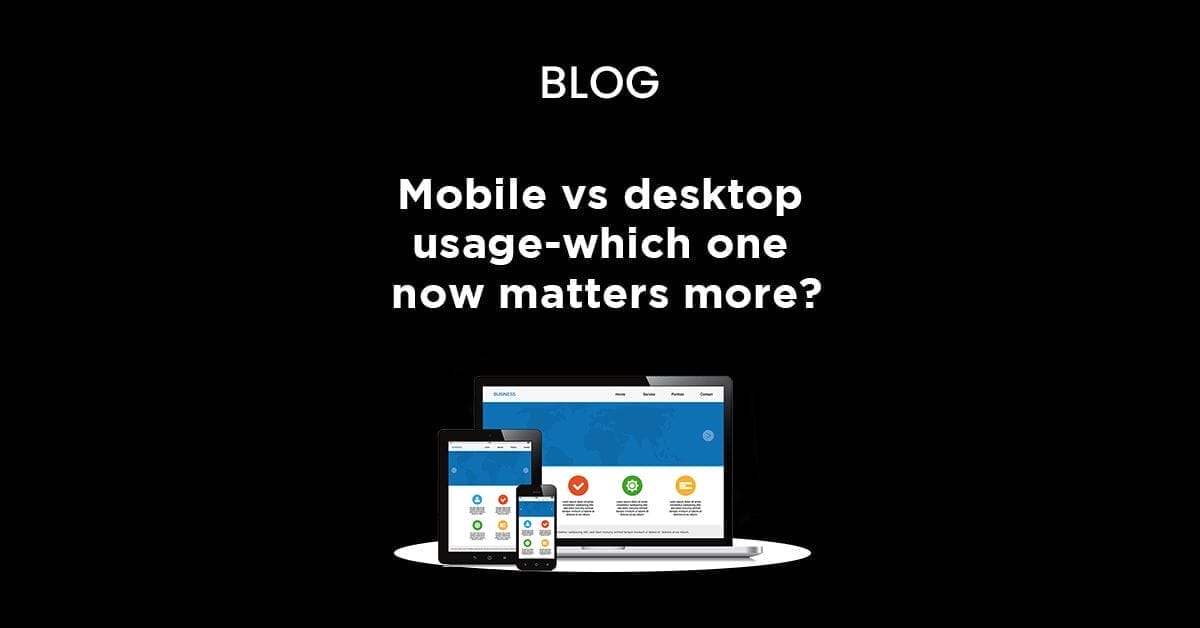Mobile vs desktop usage-which one now matters more?

With the rise of sophisticated technology, how users access the internet is constantly changing. The users want connectivity wherever they are and whenever they want; this is the new norm.
In this changing environment, businesses and organizations should catch up with the trends to provide a memorable experience to their audiences.
While the gap between mobile and desktop users is becoming more pronounced, it is necessary to find for businesses what channels their audiences are using.
For this purpose, we’ll dive into the basic differences in mobile and desktop user experience and usage statistics.
So, keep reading.
How does the user experience on mobile varies from that on desktop?
The user experience on mobile devices can vary greatly from that on desktop computers due to differences in screen size, input methods, and hardware capabilities.

- Mobiles are easy to carry as compared to desktops.
The shift towards mobile devices over desktops is largely due to the rise in mobile usage for activities such as browsing social media, sending emails, reading news, and shopping online.
A study by BroadbandSearch found that individuals spend approximately 203 minutes per day consuming media via their mobile devices.
- Wireless connection is another feature of mobiles.
The ability to connect wirelessly is another key distinction between mobile and desktop devices. Mobiles can connect to a cellular network, keeping users always connected to the internet, whereas desktops require a WiFi connection to have internet access.
- All go to apps in one place.
Mobile devices have specific apps for various purposes, such as Facebook, Twitter, Instagram, Snapchat, and many others. More business tools are also being optimized for mobile use.
On the other hand, some applications perform better on desktops due to their more organized navigation and superior graphic design, rendering them unsuitable for mobile devices.
Examples include graphic design and video editing software, productivity tools, educational apps, and IT development apps.
Statistics on Mobile vs. Desktop usage
- A report by Statcounter shows that mobiles make up 58.57% of while desktops make up 39.35% of the global tech market share.
- The use of mobile devices in learning has been found to increase motivation. A survey revealed that 70% of students reported higher motivation levels when mobile technology was incorporated into their education.
- Previously, the e-commerce conversion rate was lower for mobiles, but In 2022, 56% of e-commerce purchases were completed using mobile devices, while the rest were made on desktops.
- According to a survey by Laptop Discovery, Social media accounts for almost 25% of internet usage and is primarily accessed via mobile phones.
- According to the Hubspot marketing trends report, 41% of the emails are opened on mobiles, followed by 39% on desktops.
- Mobile devices accounted for 56% of e-commerce sales, with desktops at 44%. Despite mobile sales growth, their increase is less drastic than traffic growth.
- According to a 2022 e-commerce stats and trends report, the worldwide e-commerce traffic was 68% from mobiles and 32% from computers.
Advantages and disadvantages of using mobile phones
Mobile phones have evolved quickly to the point that companies release mobiles with more and better specifications and features each year. The tech giants sell millions of units yearly.
According to recent research, during the second quarter of 2022, Samsung was the top smartphone brand, with 62.5 million units shipped. Apple came in second place, with 46.5 million smartphones shipped.
Other companies among the top 5 are Xiaomi, Vivo, and OPPO.
Advantages
As a result, businesses have started using mobiles as channels to reach their target audience. We will discuss the advantages of using mobiles one by one.
- Convenience and accessibility
Mobile devices are portable and can be used on the go, allowing users to access information and complete tasks from anywhere.
- It has a touchscreen.
The touchscreen interface on mobile devices allows for intuitive and natural interaction, making it easier for users to complete tasks without needing a physical keyboard or mouse.
- It provides a personalized experience.
Mobile devices are personal devices often used by a single person, which allows for customization and personalization of the user experience.
Disadvantages
Where mobile phones try to provide users with the best possible user experience, mobile units have some disadvantages.
- It has a small screen size.
Small screens are a major disadvantage for users who are used to computer screens. Today mobile phones come in a wide range of screen sizes from 4”-7”, which is commonly convenient for basic use.
However, when it comes to more complex tasks, the small screen size is a setback for the users as it might accommodate much less information than on a desktop.

- It causes many distractions.
Mobiles can also be a significant distraction in many settings, such as classrooms, work, and driving. Mobile phones provide a channel to remain in contact with the world.
With that comes the continuous buzzing of notifications that causes distractions and might be the reason for decreased productivity at work.
Advantages and disadvantages of Desktop usage.
Although desktops and laptops are not as portable as mobile phones, they offer power and flexibility with a wide range of unique features that help users accomplish many tasks.
That is why desktops and laptops are not going anywhere anytime soon. According to a report, the global laptop market is expected to hit 7.2 billion from2020-24.
Advantages
Here are some of the advantages they provide.
- It has a larger screen size.
Desktops typically have larger screens than mobiles, making them ideal for tasks requiring a larger display, such as graphic design, video editing, and programming.
This larger screen size makes it easier to multitask and view multiple windows simultaneously.

- It provides improved performance.
Desktops generally have more powerful hardware components than mobiles, making them better suited for demanding gaming and video rendering tasks.
Desktops also have upgrade options, allowing users to easily upgrade components to improve performance.
- It is more reliable.
Desktops are often more reliable than mobiles, with fewer components that can fail. They are also easier to repair and maintain, making them a more sustainable choice over the long term.
Disadvantages
While desktops have several advantages, they also have several disadvantages worth considering.
- It needs more space.
Desktops also require more space than mobiles, which can be a problem for users with limited desk space.
Desktops also require additional space for a separate keyboard and mouse, which can add to the clutter.
- It has limited room for mobility.
One of the most significant disadvantages of desktops is their limited mobility. Unlike mobiles, desktops are not easily portable and are best suited for use in a fixed location, such as a home or office.
This makes them less convenient for on-the-go computing, such as working from a coffee shop or traveling.
- It is vulnerable to hardware failures.
Desktops are also vulnerable to hardware failures, such as hard drive crashes, power supply failures, and component failures. These failures can be more expensive and time-consuming than mobiles.
Final thoughts
In today’s digital age, both mobile and desktop are important, but it is important to understand user behavior and device preferences and optimize the experience accordingly.
Therefore, it’s essential for businesses and websites to have a strong presence on both mobile and desktop to cater to a diverse range of users.
